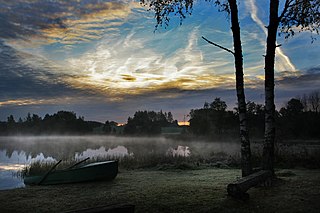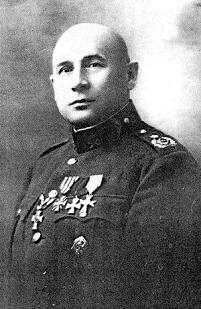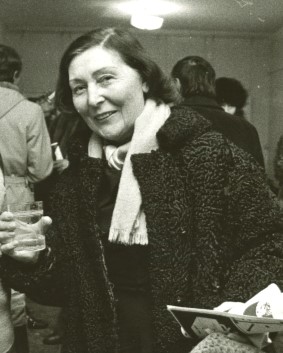
The economy of Estonia is rated advanced by the World Bank, i.e. with high quality of life and advanced infrastructure relative to less industrialized nations. Estonia is a member of the European Union and eurozone. The economy is heavily influenced by developments in the Finnish and Swedish economies.

Tallinn is the capital and most populous city of Estonia. Situated on a bay in north Estonia, on the shore of the Gulf of Finland of the Baltic Sea, Tallinn has a population of about 461,000 and administratively lies in the Harju maakond (county). Tallinn is the main governmental, financial, industrial, and cultural centre of Estonia. It is located 187 km (116 mi) northwest of the country's second largest city, Tartu; however, only 80 km (50 mi) south of Helsinki, Finland, also 320 km (200 mi) west of Saint Petersburg, Russia, 300 km (190 mi) north of Riga, Latvia, and 380 km (240 mi) east of Stockholm, Sweden. From the 13th century until the first half of the 20th century, Tallinn was known in most of the world by variants of its other historical name Reval.

The Baltic states or the Baltic countries is a geopolitical term encompassing Estonia, Latvia, and Lithuania. All three countries are members of NATO, the European Union, the Eurozone, and the OECD. The three sovereign states on the eastern coast of the Baltic Sea are sometimes referred to as the "Baltic nations", less often and in historical circumstances also as the "Baltic republics", the "Baltic lands", or simply the Baltics.

Kuressaare is a town on the island of Saaremaa in Estonia. It is the administrative centre of Saaremaa Municipality and the seat of Saare County. Kuressaare is the westernmost town in Estonia. The recorded population on 1 January 2018 was 13,276.

Võru County is a county in southern Estonia. It is bordered by Valga and Põlva counties, Latvia's Alūksne and Ape municipalities, and Russia's Pskov Oblast.

Konstantin Päts was an Estonian statesman and the country's president in 1938–1940. Päts was one of the most influential politicians of the independent democratic Republic of Estonia, and during the two decades prior to World War II he also served five times as the country's prime minister. After the 16–17 June 1940 Soviet invasion and occupation of Estonia, President Päts remained formally in office for over a month, until he was forced to resign, imprisoned by the new Stalinist regime, and deported to the USSR, where he died in 1956.

The history of Estonia from 1918 to 1940 spanned the interwar period from the end of the Estonian War of Independence until the outbreak of World War II. It covers the years of parliamentary democracy, the Great Depression and the period of corporatist authoritarian rule.
The Tallinn offensive was a strategic offensive by the Red Army's 2nd Shock and 8th armies and the Baltic Fleet against the German Army Detachment Narwa and Estonian units in mainland Estonia on the Eastern Front of World War II on 17–26 September 1944. Its German counterpart was the abandonment of the Estonian territory in a retreat codenamed Operation Aster.

Liviko is an Estonian distillery, Baltic distributor and one of the largest alcohol companies in the Baltics. Liviko was established in 1898. Liviko has its production and head office in Estonia along with distribution offices in Riga, Latvia, and Vilnius, Lithuania. Liviko exports its own products to 60 markets. The company's most well-known brands are Viru Valge vodka, Vana Tallinn liqueur, Crafter’s London Dry Gin and Crafter’s Aromatic Flower Gin. Liviko produces more than 70 alcoholic and non-alcoholic beverages.

The Estonian Soviet Socialist Republic, Soviet Estonia, or simply Estonia, was a union republic of the Soviet Union (USSR), covering the occupied and annexed territory of Estonia in 1940–1941 and 1944–1991. The Estonian SSR was nominally established to replace the until then independent Republic of Estonia on 21 July 1940, a month after the 16–17 June 1940 Soviet military invasion and occupation of the country during World War II. After the installation of a Stalinist government which, backed by the occupying Soviet Red Army, declared Estonia a Soviet constituency, the Estonian SSR was subsequently incorporated into the Soviet Union as a "union republic" on 6 August 1940. Estonia was occupied by Nazi Germany in 1941, and administered as a part of Reichskommissariat Ostland until it was reconquered by the USSR in 1944.

Estonia, officially the Republic of Estonia, is a country by the Baltic Sea in Europe. Located in Northern Europe, it has also been classified as Central or Eastern Europe in some contexts. It is bordered to the north by the Gulf of Finland across from Finland, to the west by the sea across from Sweden, to the south by Latvia, and to the east by Lake Peipsi and Russia. The territory of Estonia consists of the mainland, the larger islands of Saaremaa and Hiiumaa, and over 2,300 other islands and islets on the eastern coast of the Baltic Sea, covering a total area of 45,335 square kilometres (17,504 sq mi). Tallinn, the capital city, and Tartu are the two largest urban areas of the country. The Estonian language is the indigenous and official language of Estonia; it is the first language of the majority of its population, the world's second-most spoken Finnic language as well as the third-most spoken Uralic language.

Kristen Michal is an Estonian politician. A member of the Estonian Reform Party, he was the minister of economic affairs and infrastructure in Taavi Rõivas' cabinet between 9 April 2015 and 22 November 2016. Previously, Michal served as the minister of justice from 2011 to 2012.

Ants Kurvits or Hans Kurvits was an Estonian military commander, reaching rank of major general. He participated in the Estonian War of Independence and later became the founder and long-time leader of the Estonian Border Guard. Kurvits also served briefly as Minister of War.

Pope Francis visited the Baltic states—Lithuania, Latvia, and Estonia—from 22 to 25 September 2018.

Beer has been brewed in Estonia for over a thousand years. The first written reference to beer in what is now Estonia dates to 1284. In Estonian, beers are often described as hele (pale) or tume (dark).
The 2020–21 Baltic Men Volleyball League, known as Credit 24 Champions League for sponsorship reasons, was the 16th edition of the highest level of club volleyball in the Baltic states.

AS Postimees Grupp, formerly known as AS Postimees and AS Eesti Meedia, is an Estonian media holding company headquartered in Tallinn. The company is currently owned by MM Group, having acquired the half of the company from Norwegian company Schibsted in 2013 and bought the remaining half in 2015. The group is one of the largest media group in the Baltics. Among the Group's activities are creation of print and online media, production of television and radio, e-commerce.
Tourism in Latvia is an emerging industry in the nation of Latvia. 2.8 million visitors were recorded in 2018, an increase of 8% compared to 2017. In 2016, tourism contributed 4.5% of Latvia's GVA, and counted for 1.3 million euros in export revenue, and tourism-related industries accounted for 8.5% of total employment, or 77100 jobs in total. This was accompanied by significant growth in the number of hotels and accommodations in Latvia, rising 37% from 607 in 2018 to 831 in 2018, according to a 2020 OECD report. Most tourists in Latvia come from neighbouring countries, primarily Russia, Germany, and the other two Baltic states, Estonia and Lithuania. Most tourists stayed in Riga, the national capital. However, domestic tourism has been seeing a decline in Latvia, with less and less Latvians willing to travel abroad.

Helmi Üprus was an Estonian architectural and art historian. She trained in romance languages, studied English and ethnography, and earned a master's degree in art history from the University of Tartu in 1936. She worked her way up to head the cultural history department of the Estonian National Museum, where she researched folk art. In 1947, she began working at the Institute of History of the Academy of Sciences of the Estonian SSR. Persecuted by Stalinism she lost her job in 1950 and worked in a factory until Stalin's death. From 1953, she was the chief specialist in architecture and history for the government monument restoration service.















